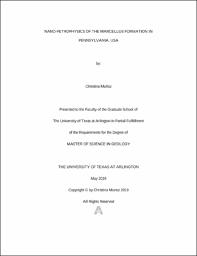
ATTENTION: The works hosted here are being migrated to a new repository that will consolidate resources, improve discoverability, and better show UTA's research impact on the global community. We will update authors as the migration progresses. Please see MavMatrix for more information.
Show simple item record
| dc.contributor.advisor | Hu, Qinhong | |
| dc.creator | Munoz, Christina Marie | |
| dc.date.accessioned | 2019-05-28T21:39:45Z | |
| dc.date.available | 2019-05-28T21:39:45Z | |
| dc.date.created | 2019-05 | |
| dc.date.issued | 2019-05-07 | |
| dc.date.submitted | May 2019 | |
| dc.identifier.uri | http://hdl.handle.net/10106/28125 | |
| dc.description.abstract | Characterizing unconventional shale reservoirs consisting of nano-size pores and pore networks are complicated due to their complex geometric structure and restrictive fluid transport abilities. Technological advancements with the use of multiple laboratory techniques for unconventional shale characterization has played key roles in determining their petrophysical properties with greater understanding and accuracy. Successful assessment of reservoir properties can be achieved by the measurement of porosity, permeability, pore size distribution, total organic carbon content, mineralogy, thermal maturity, wettability, tortuosity, with an understanding of the dispositional environments.
The Marcellus covers as much as six states and occurs as deep as 9000 feet below the surface indicating a large potential and storage capacity for natural gas. Despite the Marcellus being the top shale gas producer in the United States it’s also characterized by low porosity and permeability resulting in low-yields with declining production rates in some wells. In efforts to increase production or higher-yielding well completions in the shale, a greater understanding of the reservoir’s petrophysical properties are essential for evaluation.
This study will focus on the evaluation of nano-petrophysical properties of the Marcellus and underlying Utica that will provide additional information to the behavior of unconventional shale formations of the Appalachian basin, Pennsylvania. A series of experimental methodologies will be performed on samples gathered from five wells and two outcrops of the Marcellus and Utica formations in Pennsylvania. Analyses to be performed on samples include vacuum saturation, wettability/contact angle, x-ray diffraction (XRD), geochemistry, liquid pycnometry, mercury injection capillary pressure (MICP), imbibition and vapor absorption, and well-log analyses. Observations are then used to determine pore geometry and connectivity, migration, and storage characteristics within the Marcellus and Utica formations in the Appalachian basin, Pennsylvania. This will contribute to a better understanding of reservoir properties leading to the enhancement of well stimulation and completion methodologies for increased fluid migration and potentially increased production. | |
| dc.format.mimetype | application/pdf | |
| dc.language.iso | en_US | |
| dc.subject | Nano-petrophysics | |
| dc.subject | Marcellus | |
| dc.title | Nano-petrophysics of the Marcellus Formation in Pennsylvania, USA | |
| dc.type | Thesis | |
| dc.degree.department | Earth and Environmental Sciences | |
| dc.degree.name | Master of Science in Earth and Environmental Science | |
| dc.date.updated | 2019-05-28T21:39:45Z | |
| thesis.degree.department | Earth and Environmental Sciences | |
| thesis.degree.grantor | The University of Texas at Arlington | |
| thesis.degree.level | Masters | |
| thesis.degree.name | Master of Science in Earth and Environmental Science | |
| dc.type.material | text | |
| dc.creator.orcid | 0000-0001-5289-6425 | |
Files in this item
- Name:
- MUNOZ-THESIS-2019.pdf
- Size:
- 4.686Mb
- Format:
- PDF
This item appears in the following Collection(s)
Show simple item record


